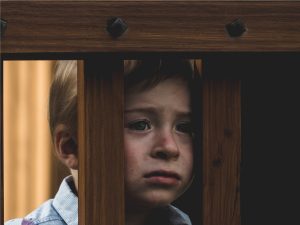 Obsessive-Compulsive Disorder is a potentially debilitating disorder that causes repetitive and intrusive thoughts (obsessions) and repetitive time-consuming rituals (compulsions) that are often distressing, debilitating, and life-altering. OCD is lifelong and occurs on a continuum with symptoms of OCD possibly increasing or decreasing throughout a person’s life.
Obsessive-Compulsive Disorder is a potentially debilitating disorder that causes repetitive and intrusive thoughts (obsessions) and repetitive time-consuming rituals (compulsions) that are often distressing, debilitating, and life-altering. OCD is lifelong and occurs on a continuum with symptoms of OCD possibly increasing or decreasing throughout a person’s life.
As a parent of a child or teen with symptoms of OCD, it can sometimes be frightening to watch your child suffer from this debilitating disorder. A natural reaction to such symptoms is to tell a child or teen to stop thinking that way or stop the behaviors, but it is not that easy to control. There is often deep-seated anxiety at the core of OCD. The thoughts (obsessions) and behaviors (compulsions) become deeply engrained and uncontrollable.
What is Obsessive-Compulsive Disorder?
Obsessive-Compulsive Disorder presents with obsessions, compulsions, or both. According to the Diagnostic and Statistical Manual of Mental Disorders Fifth Edition, OCD obsessions and compulsions are defined as follows:
Obsessions:
- “Recurrent and persistent thoughts, urges, or images that are experienced, at some time during the disturbance, as intrusive and unwanted, and that in most individuals cause marked anxiety or distress.”
- “The individual attempts to ignore or suppress such thoughts, urges, or images, or to neutralize them with some other thought or actions (i.e., by performing a compulsion).”
Compulsions:
- “Repetitive behaviors (e.g., hand washing, ordering, checking) or mental acts (e.g., praying, counting, repeating words silently) that the individual feels driven to perform in response to an obsession or according to rules that must be applied rigidly.”
- “The behaviors or mental acts are aimed at preventing or reducing anxiety or distress, or preventing some dreaded event or situation; however, these behaviors or mental acts are not connected in a realistic way with what they are designed to neutralize or prevent or are clearly excessive.”
Obsessions and/or compulsions are debilitating, time-consuming, and distressing. For OCD to be diagnosed, your child or teen must have chronic, daily, disruptive, and severe symptoms.
A person with symptoms of OCD often believes if they do a specific ritual, they will prevent the death of a loved one or stop something bad from happening. This irrational behavior increases anxiety, depression, and a sense of being out of control which starts the obsessive-compulsive cycle all over again.
While the exact cause(s) of Obsessive-Compulsive Disorder is unknown, research studies have uncovered a variety of plausible causes of pediatric OCD. The most common are genetic, environmental/parenting styles, prescription drug-induced, structural changes in the brain, inflammatory damage due to certain childhood infections, and gastrointestinal microbiome imbalances. OCD also often occurs with other psychiatric or neurodevelopmental conditions.
 While behaviors of OCD (compulsions) are often easier to diagnose in children as they are more easily observable than obsessive thoughts, it can be difficult to assess the motives behind the compulsions. Younger children may have difficulty explaining the possible connection between the obsessive thoughts and compulsive behaviors.
While behaviors of OCD (compulsions) are often easier to diagnose in children as they are more easily observable than obsessive thoughts, it can be difficult to assess the motives behind the compulsions. Younger children may have difficulty explaining the possible connection between the obsessive thoughts and compulsive behaviors.
Children and teens may also show variable patterns of OCD and the obsessions and compulsions will reflect the developmental stage of the child or teen as compared to an adult.
According to the DSM-V, suicide risk increases in those with OCD, with suicidal thoughts occurring in about half of those with OCD. Suicide attempts also occur in up to one-quarter of those with OCD. OCD can cause a child or teen to feel depressed, anxious, uneasy, embarrassed, hopeless, disgusted, and lonely.
5 Symptoms of OCD To Look for In Your Child or Teen
As children and teens develop, behaviors can rapidly change and arise. When trying to determine which behaviors are normal and which ones are more serious and in need of professional assessment it is important to look for excessive thought patterns and behaviors. The following are five of the most common symptoms of OCD parents should watch for.
1. Excessive handwashing or cleaning routines.
A child or teen with OCD may have an excessive fear of germs, illness, and dirt. Obsessive thoughts may be focused on an excessive or irrational fear of getting dirty beyond a normal desire to be clean. These obsessive thoughts may lead to compulsive behaviors such as excessive handwashing or cleaning routines that significantly impair normal functioning at their school, job, social interactions, daily activities, and other key areas.
You may notice your child or teen repeatedly washing his or her hands and sometimes needing to complete this a specific number of times before moving on to the next task. They may begin to show physical effects with noticeable injury to the hands or body from washing and/or scrubbing too often and with excessive force.
Children and teens with a fear of germs may not want to touch items they perceive as dirty which leads to a cycle of excessive cleaning of hands, body, or environment to decrease the anxiety of their fear of dirt and germs. Parents may notice their child or teen spending substantial amounts of time in the bathroom engaging in repeated cleaning behaviors.
2. Excessive checking, touching, and counting rituals.
Children and teens may try to alleviate obsessive intrusive thoughts or anxiety by repeatedly counting objects, looking for patterns and number sequences in their environment, repeatedly touching objects, and checking and rechecking to make sure a door is locked, or objects are unplugged. These compulsive behaviors bring some level of control or comfort to someone with OCD as they believe the behaviors will prevent something bad from happening, irrational or not.
Some behaviors to watch for: Your child or teen needs to touch an object x number of times to prevent the death of a loved one or some other tragedy. Your child or teen needs to check and recheck to make sure something is unplugged to prevent a fire. Your child or teen counts and recounts objects and patterns or creates number sequences to avoid or stop anxious or scary thoughts.
3. Disturbing intrusive thoughts.
 Your child or teen may articulate to you disturbing and intrusive thoughts they experience. Examples include thoughts of violence, sexual acts, harming self or others, killing a pet, or catastrophic world events. These thoughts are scary, uncontrollable, disturbing, and intrusive. The intrusive and uninviting nature of the thoughts, which can come at any time of the day, create increased anxiety and fear, and can cause a child or teen to believe they will act on the thoughts.
Your child or teen may articulate to you disturbing and intrusive thoughts they experience. Examples include thoughts of violence, sexual acts, harming self or others, killing a pet, or catastrophic world events. These thoughts are scary, uncontrollable, disturbing, and intrusive. The intrusive and uninviting nature of the thoughts, which can come at any time of the day, create increased anxiety and fear, and can cause a child or teen to believe they will act on the thoughts.
Younger children may not be able to articulate the thoughts and often exhibit depression, aggression, or anxiety to cope with the disturbing images that come unannounced. Teens may also struggle to discuss their intrusive thoughts for fear of judgment, disbelief, or fear they may get in trouble for thinking violent or irrational things. Though these thoughts may seem irrational, they are very real and frightening to your child or teen and should not be minimized or dismissed.
Another issue that may arise for your child or teen is a fear that they are sinning because the intrusive thoughts are usually taboo and sinful. With OCD, the thoughts are not intentional, deliberate, or desired. They are based on fear and not sinful intentionality.
They do not want to hold the thoughts in their head though they often will not go away. Your child or teen should be reminded that they can take comfort in knowing God searches deeper and knows the intentions of their hearts.
4. Following firm daily rules of order.
You may hear someone say they are “so OCD” about their home, daily details and tasks, or clothing. But when you notice your child or teen needing extreme order and/or daily rituals and rules that impair function, it may be time for a professional assessment.
When a child or teen is focused on firm daily rules of order, they will struggle to deviate from the rituals they have created. They may become distressed or angry if asked to change the order in which they do things. You may notice increased temper outbursts, crying, moodiness, and anxiety.
Humans are creatures of habit and some daily routines are normal. However, if your child or teen is unable to deviate from his or her daily rules of order without extreme reactions, this is a warning sign of OCD.
Examples of firm daily rules of order may include getting dressed in the same order each day, waking up at the same time without regard to daily changes or other people, needing to eat the same food daily, and other rituals that need to be performed the same way each time without flexibility. Things must always be the same. These behaviors will be extreme and excessive and disruptive to your child’s or teen’s life.
5. Excessive worry about getting sick.
 Most people do not enjoy getting sick. But children and teens with OCD may have an irrational fear of getting sick, or about others getting sick in their presence, which inhibits daily functioning. This obsession is closely related to fear of germs.
Most people do not enjoy getting sick. But children and teens with OCD may have an irrational fear of getting sick, or about others getting sick in their presence, which inhibits daily functioning. This obsession is closely related to fear of germs.
However, a specific phobia commonly exists in children and teens with OCD. This is referred to as emetophobia. This is an irrational or excessive fear of throwing up or someone near you throwing up.
This excessive fear can lead to an avoidance of eating certain foods, avoiding places or events a child or teen associates with vomiting, excessive handwashing to avoid germs that could cause vomiting, becoming hypervigilant with checking for daily symptoms of possibly throwing up, and daily irrational rituals to reduce the likelihood of throwing up (PsychCentral, 2019).
Often, symptoms of illness cause a person with OCD to believe they are ill with a life-threatening illness or disease. An excessive worry about getting sick which causes irrational fears and behaviors should be assessed by a professional.
How to Help Your Child or Teen With OCD
The first step is to recognize the signs and symptoms of OCD in your child or teen. Second, it is important to listen without judgment or punishment as the thoughts and behaviors are scary, disturbing, and uncontrollable. Your child or teen does not want to feel this way and will continue to engage in compulsive behaviors until the obsessive thoughts and compulsive behaviors are mitigated and therapeutic techniques are implemented.
Should you suspect your child or teen is dealing with OCD, seek professional help. A child psychiatrist or licensed mental health expert can diagnose OCD through a thorough evaluation and assessment.
Children and teens can be helped through therapy techniques that work to change the thinking and behaviors associated with symptoms of OCD. Reframing thoughts and finding alternative ways to reduce fears is helpful. Also, excessive behaviors will be challenged, and healthy behaviors will be implemented to limit compulsions.
Sometimes, if appropriate, the child or teen will be exposed to the fear they are avoiding, helping decrease anxious feelings and irrational behaviors. For example, if your child or teen suffers from emetophobia, a trained professional may expose him or her to unwanted food and help the child or teen process the resulting anxiety or other undesired feelings until the phobia begins to decrease while implementing new and healthy behaviors.
If you suspect your child or teen is suffering from OCD, a professional at Seattle Christian Counseling can provide warmth and acceptance along with proper assessment and treatment to help your child or teen begin to live with more freedom and peace. Your child or teen is a creation of God. He will comfort and bring ultimate healing.
Resources:
OCD and Emetophobia (psychcentral.com)
Obsessive-compulsive disorder in children and adolescents: epidemiology, diagnosis and management (nih.gov)
“Disturbed”, Courtesy of Emiliano Vittoriosi, Unsplash.com, CC0 License; “Sad Child”, Courtesy of Tadeusz Lakota, Unsplash.com, CC0 License; “Washing Hands”, Courtesy of CDC, Unsplash.com, CC0 License; “Dice”, Courtesy of Mick Haupt, Unsplash.com, CC0 License


